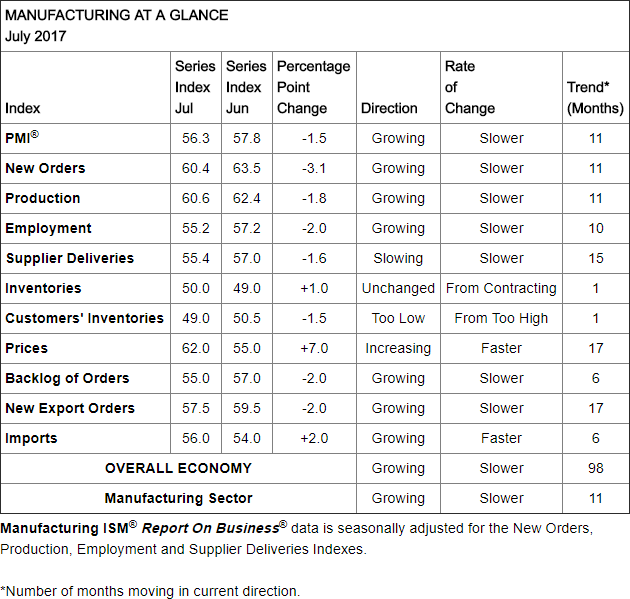ISM Manufacturing Index: Continued Expansion In July
Jill Mislinski | Aug 02, 2017 04:04AM ET
Today the Institute for Supply Management published its monthly Manufacturing Report for July. The latest headline Purchasing Managers Index (PMI) was 56.3 percent, a decrease of 1.5 percent from 57.8 the previous month. Today's headline number was below the Investing.com forecast of 56.5 percent.
Here is the key analysis from the report:
"The July PMI® registered 56.3 percent, a decrease of 1.5 percentage points from the June reading of 57.8 percent. The New Orders Index registered 60.4 percent, a decrease of 3.1 percentage points from the June reading of 63.5 percent. The Production Index registered 60.6 percent, a 1.8 percentage point decrease compared to the June reading of 62.4 percent. The Employment Index registered 55.2 percent, a decrease of 2 percentage points from the June reading of 57.2 percent. The Supplier Deliveries Index registered 55.4 percent, a 1.6 percentage point decrease from the June reading of 57 percent. The Inventories Index registered 50 percent, an increase of 1 percentage point from the June reading of 49 percent. The Prices Index registered 62 percent in July, an increase of 7 percentage points from the June reading of 55 percent, indicating higher raw materials prices for the 17th consecutive month, with a faster rate of increase in July compared with June. Comments from the panel generally reflect expanding business conditions, with new orders, production, employment, backlog and exports all growing in July compared to June, as well as supplier deliveries slowing (improving) and inventories unchanged during the period." [source ]
Here is the table of PMI components.

The ISM Manufacturing Index should be viewed with a bit of skepticism for various reasons, which are essentially captured in a previous Briefing.com "Big Picture" comment on this economic indicator.
This [the ISM Manufacturing Index] is a highly overrated index. It is merely a survey of purchasing managers. It is a diffusion index, which means that it reflects the number of people saying conditions are better compared to the number saying conditions are worse. It does not weight for size of the firm, or for the degree of better/worse. It can therefore underestimate conditions if there is a great deal of strength in a few firms. The data have thus not been either a good forecasting tool or a good read on current conditions during this business cycle. It must be recognized that the index is not hard data of any kind, but simply a survey that provides broad indications of trends.
The chart below shows the Manufacturing Composite series, which stretches back to 1948. The eleven recessions during this time frame are indicated along with the index value the month before the recession starts.
For a diffusion index, the latest reading of 56.3 is its eleventh consecutive month of expansion. What sort of correlation does that have with the months before the start of recessions? Check out the red dots in the chart above.
How revealing is today's 1.5 point change from last month? There are 835 monthly data points in this series. The absolute average month-to-month point change is 2.0 points, and the median change is 1.5 points.
Here is a closer look at the series beginning at the turn of the century.
To reiterate the Briefing.com assessment: "The data have thus not been either a good forecasting tool or a good read on current conditions during this business cycle." The ISM reports nevertheless offer an interesting sidebar to the ongoing economic debate.
Note: This commentary used the FRED here .
Trading in financial instruments and/or cryptocurrencies involves high risks including the risk of losing some, or all, of your investment amount, and may not be suitable for all investors. Prices of cryptocurrencies are extremely volatile and may be affected by external factors such as financial, regulatory or political events. Trading on margin increases the financial risks.
Before deciding to trade in financial instrument or cryptocurrencies you should be fully informed of the risks and costs associated with trading the financial markets, carefully consider your investment objectives, level of experience, and risk appetite, and seek professional advice where needed.
Fusion Media would like to remind you that the data contained in this website is not necessarily real-time nor accurate. The data and prices on the website are not necessarily provided by any market or exchange, but may be provided by market makers, and so prices may not be accurate and may differ from the actual price at any given market, meaning prices are indicative and not appropriate for trading purposes. Fusion Media and any provider of the data contained in this website will not accept liability for any loss or damage as a result of your trading, or your reliance on the information contained within this website.
It is prohibited to use, store, reproduce, display, modify, transmit or distribute the data contained in this website without the explicit prior written permission of Fusion Media and/or the data provider. All intellectual property rights are reserved by the providers and/or the exchange providing the data contained in this website.
Fusion Media may be compensated by the advertisers that appear on the website, based on your interaction with the advertisements or advertisers.